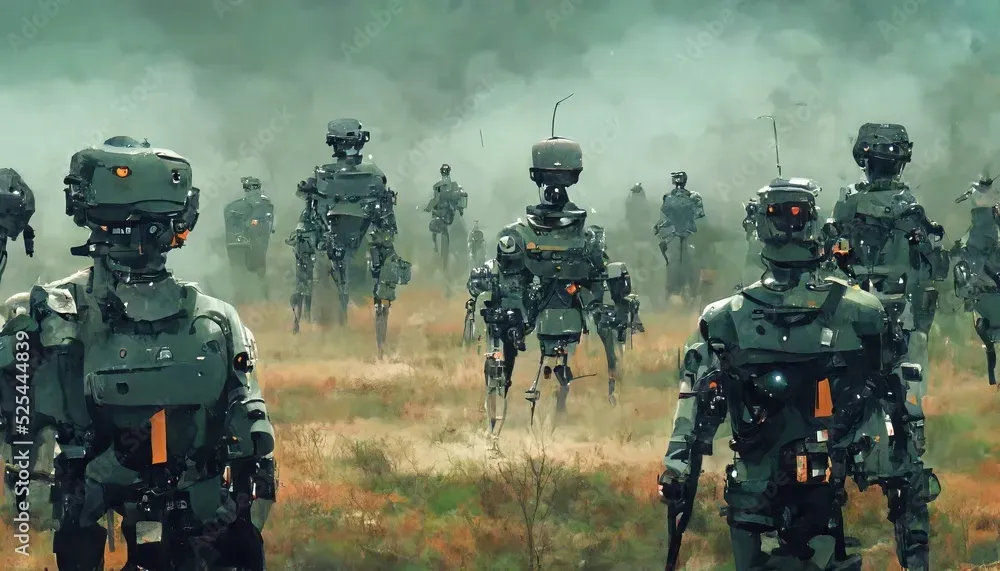In an era where technology reshapes our daily lives, the AI-powered robot army that packs your groceries in minutes stands as a revolutionary force in retail automation. This marvel of robotic warehouse technology ensures that your grocery orders are not only picked with unprecedented speed but also packed with precision, providing an efficient shopping experience that was unthinkable just a decade ago. The integration of artificial intelligence in retail is transforming traditional grocery shopping into an automated and streamlined process, allowing you to receive your groceries faster than ever. Imagine a future where grocery automation eliminates long checkout lines, and AI grocery packing becomes the norm, ultimately enhancing convenience for consumers. As we embrace these advancements, the potential of an automated grocery shopping experience is not just a dream; it’s rapidly becoming our reality.
As we delve into the realm of advanced retail solutions, the deployment of a mechanized brigade dedicated to stocking and organizing groceries exemplifies how far technology has come. This innovative assembly of automated agents is redefining the grocery landscape, shifting the paradigm of how we procure our essentials. The rise of these intelligent systems heralds a new chapter in shopping convenience, backed by the latest developments in artificial intelligence and robotics. With an effective combination of robotic warehouse technology and cutting-edge grocery automation methods, shopping for groceries is evolving, ensuring that every item is swiftly processed and delivered to your doorstep. The concept of automated grocery shopping, characterized by efficiency and speed, is reshaping consumer expectations and experiences.
The Future of Grocery Automation: How AI-Powered Robots Change Shopping
In recent years, grocery automation has advanced significantly, with technology leading the charge towards a more efficient shopping experience. The AI-powered robot army that packs your groceries in minutes signifies not just a leap in operational speed, but a transformation in how consumers approach grocery shopping. Leveraging advances in robotic warehouse technology, these robots can scan, pick, and package groceries quickly and accurately, eliminating the need for human labor in many routine tasks. This shift not only saves time but also enhances the accuracy of orders, leading to greater customer satisfaction.
Moreover, the increased use of artificial intelligence in retail is helping grocery stores optimize their inventory management. AI systems analyze purchasing patterns to predict stock requirements, minimizing waste and improving the supply chain. With automated grocery shopping becoming a norm, consumers can order groceries through their apps and receive their items packed and ready at lightning speed. This symbiotic relationship between AI and grocery stores paints a promising picture for the future, where shopping is not just convenient but also smarter.
Advantages of Robotic Warehouse Technology in Grocery Stores
Robotic warehouse technology offers numerous advantages that are revolutionizing the grocery industry. By incorporating cutting-edge AI systems, grocery chains can experience reduced operational costs and improved efficiency. The AI-powered robots in warehouses can systematically handle the logistics of order processing, from locating the items to packaging them for delivery. This not only saves time but extends the operational hours, allowing for a continuous workflow regardless of human labor availability.
Furthermore, the integration of AI in grocery management means that the traditional supply chain is being redefined. Automated grocery shopping eliminates human errors associated with manual packing and order processing. With robots handling the repetitive tasks, human workers can focus on customer service and personalized shopping experiences. This technology not only enhances productivity but allows retailers to adjust quickly to changing consumer demands, maintaining optimal stock levels and ensuring fresh produce is always available.
The Role of Artificial Intelligence in Revolutionizing Retail
Artificial intelligence is playing a critical role in transforming the retail landscape, particularly within grocery stores. Already, we see AI being used to analyze large datasets that track consumer behavior and preferences. By employing machine learning algorithms, retailers can predict trends and suggest products that appeal to specific demographics, thereby enhancing the shopping experience. This capability allows grocery businesses to tailor their offerings based on real-time data insights, ensuring that they remain competitive in an evolving marketplace.
Moreover, the demand for contactless shopping experiences has surged, making AI solutions even more relevant. Customers can use apps to generate grocery lists or even enable voice commands for hands-free shopping. AI systems streamline checkout processes, ensuring that transactions can occur rapidly and securely. With these advancements, artificial intelligence not only optimizes operations behind the scenes but also facilitates a seamless and enjoyable consumer journey, setting a new standard for retail efficiency.
Automated Grocery Shopping: Convenience at Your Fingertips
Automated grocery shopping is the wave of the future, providing consumers with an unprecedented level of convenience. Shoppers can select their items through user-friendly apps that utilize AI to enhance the selection process. Not only can consumers quickly browse through their favorite brands and products, but they can also receive personalized recommendations based on their shopping history. This not only saves time but ensures a tailored shopping experience that meets individual needs.
In addition, the rise of automated grocery services means that delivery options have vastly improved. With advances in robotic technology and efficient logistics powered by AI, consumers can expect their groceries to be delivered at their convenience. The integration of smart tracking features allows customers to monitor their order status in real-time, reinforcing trust and transparency in the grocery shopping process. This shift signifies a significant move towards a more automated, efficient, and consumer-focused industry.
Revolutionizing Supply Chains Through AI and Automation
The grocery supply chain is undergoing a major transformation due to the intersection of AI and automation technologies. With advanced predictive analytics, retailers can better manage their inventory levels, ensuring that fresh products always meet customer demand. This not only reduces waste but also enhances profitability by minimizing excess stock. Robotics in warehousing further streamlines this process, allowing for faster replenishment and fulfillment.
AI technologies are enabling grocery stores to respond in real-time to market fluctuations and shifting consumer trends. With an intelligent system in place, businesses can adjust their inventory distribution based on predictive data. Such innovations mean that grocery chains can not only keep pace with demand but also maintain a competitive edge. The future looks bright, as AI and robotic warehouse technology continue to refine and redefine the grocery supply chain.
Enhancing Customer Experiences with AI-Powered Solutions
As grocery stores increasingly adopt AI-powered solutions, customers are beginning to enjoy enhanced shopping experiences. AI not only facilitates personalized recommendations but also streamlines the shopping process to reduce wait times. For instance, smart carts equipped with AI can help customers find products more efficiently within the store, creating a seamless navigation experience that encourages exploration and impulse buying.
Additionally, the integration of chatbots in grocery apps allows shoppers to seek assistance any time of day. These virtual assistants can answer questions about product availability, suggest alternatives, or provide nutritional information, drastically improving customer service without the need for additional staff. By creating a more engaging environment, grocery stores using AI technology can foster stronger customer loyalty and satisfaction.
Sustainability Initiatives in Grocery Automation
With sustainability becoming a crucial focus for grocery retailers, AI and automation play a pivotal role in enhancing eco-friendly practices. Automated grocery shopping systems can ensure optimal inventory levels, thereby reducing food waste significantly. The ability of AI to analyze purchasing trends allows retailers to stock items that are more likely to be sold, thus lowering the chances of surplus waste ending up in landfills.
Moreover, robotic warehouse technology contributes to the sustainability narrative by minimizing energy consumption during operations. AI-driven optimization processes can reduce energy use linked to refrigeration, packaging, and transport logistics. By adopting these advanced technologies, grocery chains can not only improve their bottom line but also align with modern consumer expectations for sustainability and corporate responsibility.
Challenges in Implementing Grocery Automation Technologies
While the implementation of AI-powered grocery automation presents numerous benefits, there are challenges that retailers must navigate. High initial investment costs for technology adoption and infrastructure upgrades can deter some businesses from making the shift. Furthermore, the integration of robotic systems with existing processes may require significant adjustments to workforce structures and operational workflows, leading to potential resistance from employees.
Additionally, concerns about data privacy and security are paramount when utilizing AI for grocery automation. Retailers must ensure they are compliant with regulations while protecting customer information from potential breaches. Balancing these challenges with the drive for innovation will be crucial as the grocery industry continues to evolve with technology.
The Economic Impact of Grocery Automation on Employment
The rise of grocery automation, particularly through AI and robotics, is reshaping the employment landscape within the retail industry. As grocery servers become more automated, there is a concern regarding job displacement for traditional roles. However, the reality may suggest a shift rather than a total loss of employment opportunities; new roles are emerging that focus on managing, maintaining, and improving these technologies.
Moreover, workers may find opportunities in areas that emphasize customer interaction and service. As repetitive tasks become automated, grocers can allocate human resources towards more engaging customer-facing roles. This shift presents the potential for enhanced job satisfaction as employees focus on tasks that require creativity and critical thinking, marking a transition to a new era in the workforce.
Frequently Asked Questions
How does an AI-powered robot army improve grocery automation?
An AI-powered robot army enhances grocery automation by efficiently picking and packing items in a fully automated warehouse system. This technology enables complete grocery orders to be processed within minutes, significantly reducing wait times for customers and minimizing human error in the packing process.
What role does AI grocery packing play in the future of retail?
AI grocery packing is set to transform retail by streamlining operations and boosting productivity. With robots handling the packing, stores can ensure faster service and better inventory management, leading to improved customer satisfaction and operational efficiency.
What are the benefits of robotic warehouse technology in grocery shopping?
Robotic warehouse technology in grocery shopping provides numerous benefits, including faster order fulfillment, reduced labor costs, and enhanced accuracy in picking items. This technology allows for a more efficient supply chain, ensuring that customers receive fresh products quickly.
How is artificial intelligence in retail transforming grocery stores?
Artificial intelligence in retail is transforming grocery stores by automating various processes, such as inventory management and customer service. AI technologies streamline operations, improve supply chain efficiency, and enhance the overall shopping experience for consumers.
What advantages does automated grocery shopping offer consumers?
Automated grocery shopping offers consumers numerous advantages, including reduced shopping times, increased accuracy in picking and packing, and a seamless shopping experience. With an AI-powered robot army, customers can expect their groceries packed and ready for delivery within minutes.
| Feature | Details |
|---|---|
| AI-Powered Robot Army | A system designed to pack groceries quickly, enhancing shopping efficiency. |
| Speed of Service | Processes entire grocery orders in just five minutes without human intervention. |
| Impact on Shopping | Revolutionizes traditional shopping experiences, making them faster and more automated. |
| Technological Advancement | Utilizes AI algorithms and robotics to streamline packing and delivery processes. |
| Future Innovations | Anticipated advancements in AI, including AI digital employees in corporate environments. |
| Broader Applications | AI technology also impacts various sectors including boating (hydrogen engines) and recycling. |
Summary
The AI-powered robot army is truly reshaping the grocery shopping landscape. By automating the packing process to efficiently handle orders in mere minutes without human touch, this innovative system not only enhances customer convenience but also transforms retail logistics. As AI technology continues to advance and integrate into various industries, we can expect even more revolutionary changes that enhance efficiency and sustainability.

